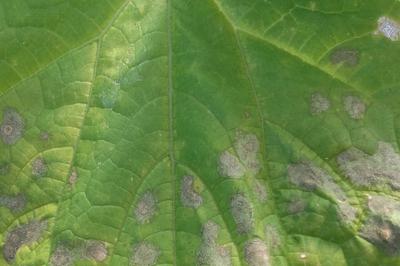Cucumber Scab
Cladosporium cucumerinum
Fungus
In a Nutshell
- Small, water-soaked or pale green spots on leaves.
- Later dry and leave ragged holes.
- Small, gray, gum-oozing spots on fruits that later become sunken cavities.
- Fruit decay due to secondary bacterial infection.
Can also be found in
Symptoms
Leaf symptoms appear as numerous small, water-soaked or pale green spots. These spots gradually dry and die, turning white to gray and becoming angular. Often, the lesions are surrounded by a yellowish halo. Their center may tear away, leaving ragged holes in the leaves. Most severe symptoms develops on the infected fruits, and resemble insect stings. Small (about 3 mm), gray, slightly sunken, gum-oozing spots appear first. Later, the spots enlarge and finally become distinct sunken cavities or scabs. Affected fruit are often invaded by opportunistic pathogens such as soft-rotting bacteria that produce a mushy, foul-smelling decay. On highly resistant fruits, especially on certain squashes and pumpkins, irregular, knob-like formations may develop.
Recommendations

Organic Control
Direct biological treatment of cucumber scab is not possible. Use fungicides based on a copper-ammonium complex that is certified organic to slow down the spread of the pathogen.

Chemical Control
Always consider an integrated approach with preventive measures together with biological treatments if available. Use fungicides containing chlorothalonil or based on a copper-ammonium complex. Seeds can be surface-disinfected with 0.5% sodium hypochlorite for 10 min to eliminate the pathogen. Fungicides containing dithiocarbamates, maneb, mancozeb, metiram, chlorothalonil and anilazine are also effective against C. cucumerinum.
What caused it?
The symptoms are cause by the fungus Cladosporium cucumerinum, which overwinters in plant residues, in cracks in the soil or on infected seeds. Early spring infection may come from either of these sources. The fungus begins to develop spore-producing structures and release spores. Spores are spread by insects, clothing or tools, or are blown long distances in moist air. High air humidity and moderate temperatures increase the risk of infection. Temperatures around 17 °C and alternating between 12-25 °C, together with moist weather, frequent fogs, dews or light rain are the most favorable for the development of the fungus. Symptoms can appear 3 to 5 days after the penetration of the fungus in the plant tissues has taken place.
Preventive Measures
- Use seeds from healthy plants or from certified sources.
- Plant resilient varieties if available.
- Choose well-drained sites for your plantation.
- Cultivate cucurbits during late spring, summer and early autumn, as scab formation is not favored at warm temperatures.
- Crop rotation with non-host crops, such as maize, is recommended (2 or more years).
- Control weeds and volunteer cucurbit plants.
- Do not work in fields when plants are wet with rain or dew.
- Ensure sufficient space and aeration between plants to reduce humidity.
- Do not overwater and avoid sprinkler irrigation.
- Monitor the crops regularly for symptoms.
- Remove and destroy (burn or bury) infected plants and plant debris.
- Disinfect pots and flower boxes as well as other tools and materials used in cucurbit growing and harvesting.



